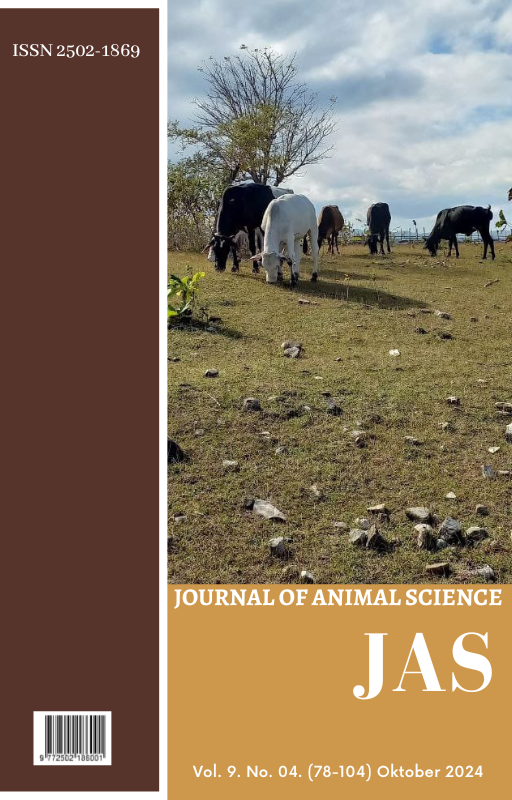Microsatellite (RM20A, RM241, and RM315) Amplification of Panic Grass DNA (Panicum maximum)
DOI:
https://doi.org/10.32938/ja.v9i4.7537Keywords:
Panic Grass, Molecular Marker, DNA, SSR, PCRAbstract
Forage is a very important element for livestock development as they need it to survive, produce and reproduce. The forages that is often used is panic grass (Panicum maximum) which is a feed grass from the African plains, widely used in various regions of Indonesia. This grass is used for their high nutritional value, the ability to adapt various types of soil and weather, and usage as an ideal or high quality “cut and carry” grass for beef and dairy cattle. Forage cultivation by considering plant genetics can improve the quality of all types of forage inherited from the parent hence increase the productivity of feed crops and support livestock development. This can be done with molecular marker, which is a technology that can confirm target genes effectively, efficiently and accurately and are not influenced by environmental factors. Among the markers or molecular markers currently available, microsatellites or Simple Sequence Repeats (SSR) have become a marker system that is commonly used because of its various advantages, namely that it can be amplified by Polymerase Chain Reaction using primers that combine sequences in the target DNA. In this research, genes that carry leaf-rolling, plant height, and fertility-restoring properties that have previously been identified in rice plants will be tested on panic grass using RM20A, RM241, RM315. After being visualized using electrophoresis gel, it can be concluded that RM241 had the best result as it has clear amplification result and polymorphic bands with effectiveness and polymorphism levels of 75% and 100% respectively.
References
Aganga, A.A., and Tshwenyane, S. 2004. Potentials of Guinea grass (Panicum maximum) as forage crop in livestock production. Pak J Nutr. 3: 1-4.
Babu, B.K., J. Anjeli, S. Sood, & P.K. Agrawal. 2017. Identification of microsatellite markers for finger millet genomics application through cross transferability of rice genomic SSR markers. Indian Journal of Genetics and Plant Breeding. 77(1): 92-98. DOI : 10.5958/0975-6906.2017.00012.8.
Babu, B.K., S. Sood, D. Kumar, A. Joshi, A. Pattanayak, L. Kant, & H.D. Upadhyaya . 2018. Cross genera transferability of rice and finger millet genomic SSRs to barnyard millet (Echinochloa spp.). 3 Biotechlogy. 8(2). DOI : 10.1007/s13205-018-1118-1.
Carnevalli, R.A, Silva, S.C., Bueno, A.A.O., Uebele, M.C., Bueno, F.O., Hodgson, J., Silva, G.N., & Morais, J.P.G. 2006. Herbage production and grazing losses in Panicum maximum cv. Mombaςa under four grazing managements. Trop Grassl. 40: 165-176.
Dwiwandana, B., I. K. Suatha, dan I. N. Wandia. 2013. Karakteristik Lokus Mikrosatelit D7S1789 pada Populasi Monyet Ekor Panjang (Macaca fascicularis) di Wenara Wana, Padang Tegal, Ubud, Bali. Indonesia Medicus Veterinus. 2(4): 375-384.
Ethica, S. N., Nataningtyas, D. R., Lestari, P., Istini, Semiarti, E., Widada, J., & Raharjo, T. J. 2013. Comparative evaluation of conventional versus rapid methods for amplifiable genomic DNA isolation of cultured Azospirillum sp. JG3. Indonesian Journal of Chemistry. 13(3): 248-253.
Grattapaglia, D., Chaparro, J., Wilcox, P., McCord, S., Werner, D., Amerson, H., McKeand, S., Bridgwater, F., Whetten, R., O’Malley, D., & Sederoff, R. 1992. Mapping in woody plants with RAPD markers: application to breeding in forestry and horticulture. Application of RAPD Technology to Plant Breeding. Joint Plant Breeding Symposia Series CSSA/ASHS/AGA.
Hairinsyah. 2010. Pendugaan parameter genetik dan analisa keragaman genetik kelapa sawit (Elaeis guineensis Jacq) dengan marka Simple Sequence Repeat (SSR). [Tesis]. IPB. Bogor.
Jank, L., J.A. Martuscello, R.M.S. Resende, & C.B. Valle. 2010. Panicum maximum Jacq. p . Vicosa: In Fonseca DM and Martuscello JA (Eds.) Plantas Forrageiras. Editora UFV.
Krupa, K.N. & H.E. Shashidhar. 2017. Transferability of rice SSR markers to Sorghum. Mysore Journal of Agricultural Sciences. 51(3): 584-589.
Lee, E.J., G.Y. Nah, M.J. Yook, S.H. Lim, T.S. Park, D.K. Lee, & D.S. Kim. 2016. Phylogenetic relationship of Echinocloa species based on simple sequence repeat and phenotypic marker analyses. Weed Science 64(3): 441-454. DOI : 10.1614/WS-D-15-00187.1.
McCouch, S.R., L. Teytelman, Y. Xu, KB. Lobos, K. Clare, M. Walton, B. Fu, R. Maghirang, Z. Li, Y. Xing, Q. Zhang, I. Kono, M. Yano, R. Fjellstrom, G. DeClerck, D. Schneider, S. Cartinhour, D. Ware, & L. Stein. 2002. Development and mapping 2240 new SSR markers for rice (Oryza sativa L.). DNA Research. 9(6): 199-207. DOI : 10.1093/dnares/9.6.199.
Miah, G., M.Y. Rafii, M.R. Ismail, A.B. Puteh, H.A. Rahim, K.N. Islam, & M.A. Latif. 2013. A review of microsatellite markers and their applications in rice breeding programs to improve blast disease resistance. International Journal of Molecular Sciences. 14(11): 22499-22528. DOI : 10.3390/ijms141122499.
Muladno. 2010. Teknologi Rekayasa Genetika, Edisi Kedua. Bogor: IPB.
Nakamanee, G., Srisomporn, W., Phengsavanh, P., Samson, J., & Stür, W. 2008. Sale of fresh forage a new cash crop for smallholder farmers in Yasothon, Thailand. Trop Grassl. 42: 65-74.
Panaud, O., Chen, X., & Mc Couch, S. R. 1996. Oryza Sativa subsp. Indica Microsatellite Markers RM20A and RM20B, Sequence Tagged Site.
Pandey, S., Sharma, V., & Alam, A. 2016. Potential of microsatellites markers for the genetic analysis of Bryophytes. Not. Sci. Biol. 8(1): 37–46.
Ramlah, I.R., Aziz, C. Muthiadin, M. Masri, M.K. Mustami, & M.B. Pabendon. 2017. Genetic diversity of local maize germplasm of Tana Toraja South Sulawesi using SSR (Simple Sequence Repeat). Ilmu Pertanian. 2(3): 144-153. DOI: 10.22146/ipas.33085.
Shiposha, V., P. Catalán, M. Olonova, & L. Marques. 2016. Genetic structure and diversity of the selfing model grass Brachypodium stacei (Poaceae) in Western Mediterranean: out of the Iberian Peninsula and into the islands. Peer Reviewed Journal. e2407. DOI : 10.7717/peerj.2407.
Simarmata, M., Inoriah, E., & Haquarsum, E.J.V. 2014. Optimalisasi PCR-RAPD dan Identifikasi Morfologi Tanaman Kumis Kucing di Provinsi Bengkulu. Agrosia. 17(2): 190-200.
Trivino, N.J., J.G. Perez, M.E. Recio, M. Ebina, N. Yamanaka, S.I. Tsuruta, M. Ishitani, & M. Worthington. 2017. Genetic diversity and population structure of brachiaria species and breeding populations species and breeding populations. Crop Science. 57: 2633-2644. DOI : 10.2135/cropsci2017.01.0045.
Uslan & Pharmawati, M. 2015. Optimization of DNA and MgCl2 Concentrations in Polymerase Chain Reaction. Bioslogos. 5(1). DOI: 10.35799/jbl.5.1.2015.9316.
Van Oosten, M.J., A. Costa, P. Punzo, S. Landi, A. Ruggiero, G. Batelli, & S. Grillo. 2016. Genetics of drought stress tolerance in crop plants. Drought Stress Tolerance in Plants. 2: 39-70. DOI : 10.1007/978-3-319-32423-4.
Williams, J.G. and Ronald I.A. 1990. DNA polymorphisms amplified by arbitrary primers are useful as genetic markers. Nucleic Acids Res. 18(22): 6531-6535.
Zulfahmi. 2013. Penanda DNA untuk analisis genetik tanaman. Jurnal Agroteknologi. 3(2): 41-52.
Downloads
Published
How to Cite
Issue
Section
License
Copyright (c) 2024 Adrian Ramadhan Gananto, Romi Zamhir Islami, Mansyur Mansyur, Estria Furry Pramudyawardani

This work is licensed under a Creative Commons Attribution-NonCommercial 4.0 International License.
The journal is committed to free-open access that does not charge readers or their institutions for access. Readers are entitled to read, download, copy, distribute, print, search, or link to the full texts of articles, as long as not for commercial purposes. The license type is CC BY-NC 4.0.









.png)
.jpg)

